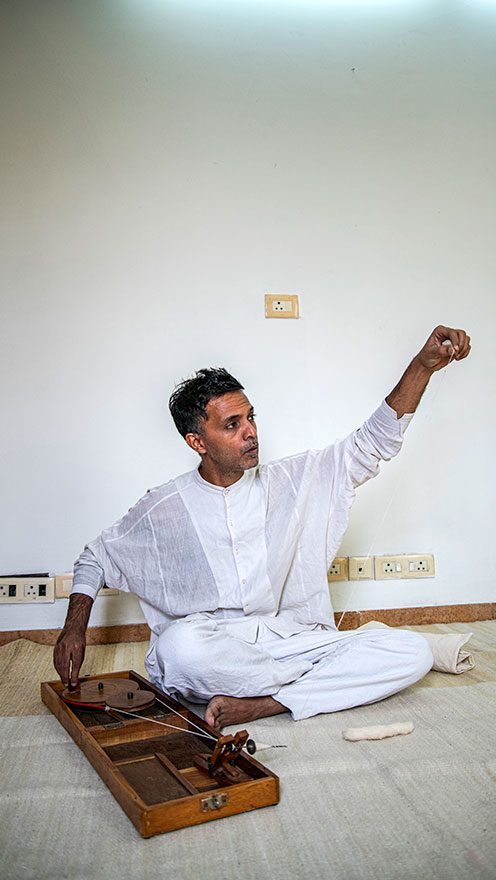‘Design for Regeneration’ – Understanding farm to fashion value chain through producers, materials, dyes, certification and more.
This ‘CraftxClimate’ discussion has been developed in collaboration with Fashion Revolution India as part of Fashion Revolution Week | 20 April 2024
Speakers –
Himanshu Shani, co-founder, 11.11/Eleven Eleven and
Ateev Anand, Wear Teev and Re-ceremonial
Moderator – Bhavya Goenka, Founder & Designer, Iro Iro
Context and Takeaways
Regenerative fashion refers to clothing made in ways that support circularity — either through the used economy by upcycling materials otherwise discarded or through the soil-to-soil cycle of regenerative agriculture. 1
The fashion industry in India has immense potential to pivot towards regenerative design and sustainable practices. The decisions made at the design and development stage have huge impacts on a product’s environmental footprint throughout its entire lifecycle – from the raw materials used, to how it is manufactured, the length of time it is kept in use and what happens to it when it is no longer desired by its owner or cannot be used any more. In fact, as much as 80% of a product’s impact is determined at the design stage. 2


Designers must approach design with an investigative mindset, questioning every aspect from material sourcing to end-of-life, and collaborate with artisans to build scalable solutions. Aesthetics and customer trust are crucial in driving the shift towards a more conscious and circular economy. The speakers for this session, Himanshu Shani and Ateev Anand discuss the importance of questioning and reevaluating current practices in design and production to incorporate regenerative aspects. They talk about exploring the different perspectives of regenerative design from the producer and consumer sides as a designer besides the importance of questioning consumption practices.
Investigative Approach to Achieving Sustainability


Ateev emphasizes the importance of adopting an investigative approach when working with materials. He illustrates this point with an experiment involving the creation of products, such as socks, using a blend of recycled materials: 70% post-consumer textiles and 30% recycled polyester from PET bottles. However, during this endeavour, he encountered challenges related to microplastics within this material mix. Consequently, Ateev made a transition towards more sustainable solutions, opting for 100% cotton yarn instead.
Drawing from 22 years of design expertise, Himanshu underscores the crucial journey of fortifying the seed-to-stitch narrative. His holistic approach to sustainability is a testament to this commitment, starting with meticulous examinations of material origins, notably focusing on cotton. Progress extends to interventions spanning natural dyeing, filament choices, and labelling practices.




Despite strides made, Himanshu acknowledges the barrier synthetic materials pose to apparel biodegradability. Over the past decade, his brand’s pursuit has been developing 100% sustainable solutions. He emphasizes that transferring knowledge based on best practices across production clusters is pivotal for scalability. For Himanshu, it’s not just a strategy; it’s the indispensable route toward realizing the harmonious blend of crafts and fashion for regeneration.
Tracebility
11:11/Eleven Eleven in a pioneering move has embedded NFC chips for tracebility in their products. It ensures each product’s status is known in real-time, promoting transparency and accountability in the production chain. The implementation of RFID technology like NFC chips allows consumers to connect with the makers behind the products, fostering a deeper appreciation for craftsmanship and promoting transparency.
Product is the King
Both speakers along with the moderator agreed that aesthetics play a crucial role in driving consumer interest to eco-friendly products and promoting a positive shopping experience.
Challenges and Nuances of Certification
Certification in the industry is fraught with challenges eg. its affordability, access or value for a farmer already growing organic cotton or lack of policy mandates in domestic material market for compliances.
Brands can become catalyst in this dialogue through product presentation and storytelling for gaining customer trust and support for sustainability initiatives. Visual narrative plays a significant role in conveying authenticity over certifications.
Future of Fashion
The future of fashion is shifting towards a more informed consumer who values sustainability and individuality, contrasting with the current focus on external perceptions. The evolving priorities of younger consumers is shifting towards value-driven and sustainable fashion choices, emphasizing personal values over trends and body type. There is a vast potential for growth and innovation in the Indian fashion industry.
An advice for aspiring designers is to prioritize discipline and product-oriented thinking in a saturated market, emphasizing the need for meaningful and purposeful design.
More about Speakers and Moderator


Himanshu Shani has long been at the forefront of the sustainability conversation in India. His 15 years old, New Delhi-based brand 11.11 /eleven eleven (with co entrepreneur Mia Morikawa) is a testament to design being a pathway for social and ecological regeneration, with consumer connect, commercial viability, traceability and design distinction intact.
Ateev Anand has been dedicated to understanding and establishing circular practices in textile consumption through his brand re- launched in 2020. In 2022, he launched Re-ceremonial at GenNext Lakmé Fashion Week. This is a line of high-end ceremonial clothing crafted entirely from climate positive textiles and plant dyes.




Bhaavya Goenka is founder of Iro Iro, a zero-waste upcycling studio based in Jaipur that leads with a people-environment mindset. Bhaavya is also the regional ambassador of Fashion Revolution India representing the textile-abundant city of Jaipur.
- https://www.madetrade.com/blogs/magazine/what-is-regenerative-fashion ↩︎
- Textile 2030 Roadmap
https://wrap.org.uk/sites/default/files/2022-04/WRAP-textiles-2030-circularity-roadmap-20220331.pdf ↩︎
CraftxClimate
Creative Dignity’s “CraftxClimate” initiative aims to position the crafts sector at the forefront of UN SDG 12 ‘Responsible Production and Consumption’ through issue identification, knowledge sharing, capacity building, and advocating sustainable solutions. Join us as we explore climate-resilient growth paths for handmade businesses together! Our exciting lineup of conversations and masterclasses with industry experts focuses on crafting a sustainable future.